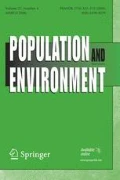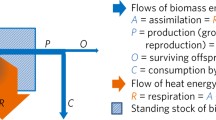Abstract
Along with decreasing doubling times as a function of increasing rates of population growth over the past several thousand years, the human species has shown striking parallels with a malignant growth. Some cancers also display decreasing doubling times of cell proliferation during the most rapidly growing phase. At 6 billion, the number of doublings reached by the human population as of 1998 is 32.5, with the 33rd doubling (8.59 billion) expected early in the next century. In terms of total animal biomass, including that of domestic animals under human control, the 33rd doubling of human-related biomass has been passed. In terms of energy use, which is a more accurate, index of the global ecological impact of humans, the human species has passed its 36th doubling. These calculations are important because, in addition to the number of doublings, the human population is showing several important similarities with a malignant organismic tumor, which results in death of the host organism at between 37 and 40 doublings. At current growth rates, the number of individual humans will reach those levels within 200–400 years from the present, but the ecological impact will be felt much sooner since the number of doublings of energy consumed will pass 37 early in the next century. These observations support the hypothesis that the human species has become a malignant process on the planet that is likely to result in the equivalent, for humans, of ecosystem death, or at least in a radical transformation of the ecosystem, the early phases of which are being observed.
Similar content being viewed by others
References
Andrewartha, H.G., and Birch, L.C. (1954). Seasonal changes in a population of adult thrips living on rose bushes.The Distribution and Abundance of Animals. Chicago: University of Chicago Press.
Bartlett, A.A. (1993). The arithmetic of growth: Methods of calculation.Population and Environment, 14(4), 359.
Bongaarts, J. (1993).The fertility impact of family planning programs (Working Papers No. 47), New York: The Population Council.
Bongaarts, J. (1994). Population policy options in the developing world.Science, 63(5148), 771.
Bongaarts, J. (1998). Demographic consequences of declining fertility.Science, 282(5388), 419.
Bourgeois-Pichat, J. (1967). Social and biological determinants of human fertility in nonindustrial societies.Proceedings of the American Philosophical Society, 111, 160.
Brundtland, G.H. (1997). The scientific underpinning of policy.Science, 277(5325), 457.
Coleman, G.J. and Dewar, D. (1997).The Addison-Wesley Science Handbook, Don Mills, Ontario: Addison-Wesley Publishers Limited.
Cook, E. (1976).Man, Energy, Society, San Francisco: W. H. Freeman.
Crosby, A.W. (1986).Ecological Imperialism: The Biological Expansion of Europe, 1000–1900. Cambridge: Cambridge University Press.
Edelson, E. (1991). Tracing human lineages.Mosaic, 22(3), 56.
Ehrlich, P.R., and Roughgarden, J. (1987).The Science of Ecology (pp 66–72). New York: Macmillan.
Emiliani, C. (1988).The Scientific Companion. New York: John Wiley & Sons.
Energy Information Administration (1998).International Energy Annual 1998. Washington, DC: U.S. Department of Energy.
Fischer, G. (1993). The population explosion: Where is it leading?Population & Environment, 15(2), 139.
Frisancho, A.R. (1990).Anthropometric Standards For The Assessment of Growth and Nutritional Status. Ann Arbor: University of Michigan Press.
Hammond, A.L. (Ed.). (1992).World Resources 1992–93. New York: Oxford University Press. A Report by the World Resources Institute, United Nations Environment Programme, and the United Nations Development Programme.
Harpending, H., Sherry, S., Rogers, A., and Stoneking, M. (1993). The genetic structure of ancient human populations.Current Anthropology, 34(4), 438.
Hassan, F. (1980). The growth and regulation of human population in prehistoric times. In M.N. Cohen, R.S. Malpass, & H.G. Klein (Eds.),Biosocial Mechanisms of Population Regulation. New Haven: Yale University Press.
Hern, W.M. (1977). High fertility in a Peruvian Amazon Indian village.Human Ecology, 5, 355.
Hern, W.M. (1990). Why are there so many of us? Description and diagnosis of a planetary ecopathological process.Population & Environment, 12(1), 9.
Hern, W.M. (1992). Polygyny and fertility among the Shipibo of the Peruvian Amazon.Population Studies, 46, 53.
Hern, W.M. (1993). Is human culture carcinogenic for uncontrolled growth and ecological destruction?BioScience, 43(11), 768.
Hole, F. (1994). The calibration of domestication. Presented at the American Association for the Advancement of Science, February, 1994.
Keyfitz, N. (1993). Population alarm and demographers' calm. Paper presented at the Population Association of America annual meeting, Cincinnati, April 1993.
Lewin, R. (1991). The biochemical route to human origins.Mosaic, 22(3), 46.
Lindeburg, M.R. (1995).Engineering Unit Conversions (3rd ed.). Belmont, CA: Professional Publications, Inc.
MacLulich, D.A. (1937).Changes in the abundance of lynx and snowshoe hare (University of Toronto Studies, Biological Series No. 43, pp 1–136).
McCorriston, J. and Hole, F. (1991). The ecology of seasonal stress and the origins of agriculture in the Near East.American Anthropologist, 93(1), 46.
McNeill, W.H. (1974).Plagues and Peoples. Garden City: Anchor Press/Doubleday.
Meyer, F. (1959). L'acceleration de l'evolution. InL'Encyclopedie Francaise. Paris, Larousse 20, 20–24.1
Pearl, R. (1922).The Biology of Death, Philadelphia: J.B. Lippincott.
Pearl, R. (1924).Studies in Human Biology. Baltimore: Williams and Wilkins.
Pearl, R. (1939).The Natural History of Population. New York: Oxford University Press.
Relethford, J. (1990).The Human Species. Mountain View, California: Mayfield Publishing Company.
Slingerland, J.M., and Tannock, I.F. (1998). Cell proliferation and cell death. In I.F. Tannock and R.P. Hill (Eds.),The Basic Science of Oncology. (3rd ed.). New York: McGraw-Hill, Inc.
Stringer, C.B. (1993). New views on modern human origins. In D.T. Rasmussen (Ed.),The Origin and Evolution of Humans and Humanness. Boston: Jones and Bartlett.
Stringer, C.B., and Andrews, P. (1988). Genetic and fossil evidence for the origin of modern humans.Science, 239, 1263.
Tannock, I.F. (1989). Principles of cell proliferation: Cell kinetics. In V.B. DeVita, Jr., S. Hellman, & S.A. Rosenberg (Eds.),Cancer: Principles and Practice of Oncology (pp. 3–13). Philadelphia: J.B. Lippincott Co.
Tannock, I.F. (1992). Cell proliferation. In I.F. Tannock and R.P. Hill (Eds.),The Basic Science of Oncology. (2nd ed.). New York: McGraw-Hill, Inc.
Umpleby, S.A. (1990). The scientific revolution in demography.Population & Environment, 11(3), 159.
United Nations. (1992). The 1992 revision of world population prospects.Population Newsletter No. 54. New York: Population Division, Department of Economic and Social Development, United Nations Secretariat.
U.S. Census Bureau. (1998, June 15).Total Midyear Population for the World: 1950–2050. <http://www.census.gov/ipc/www/worldpop.html>
Vitousek, P.M., Ehrlich, P.R., Ehrlich, A.H., and Matson, P.A. (1986). Human appropriation of the products of photosynthesis.BioScience, 36(6), 368.
Vitousek, P.M., Mooney, H.A., Lubchenco, J., and Melillo, J.M. (1997). Human domination of earth's ecosystems.Science, 277(5325), 494.
von Foerster, H. (1959). Mathematics of cellular kinetics. In F. Stohlman, Jr. (Ed.),The Kinetics of Cellular Proliferation (p. 391). New York: Grune & Stratton.
von Foerster, H., Mora, P.M., and Amiot, L.W. (1960). Doomsday: Friday, 13 November, A.D. 2026.Science, 132(3436), 1291.
von Foerster, H., Mora, P.M., and Amiot, L.W. (1961). Letter.Science, 133(3456), 936.
von Foerster, H. (1966).The numbers of man, past and future (BCL Report 13.0), Urbana, Illinois: Department of Electrical Engineering, University of Illinois.
Weeks, J.R. (1992).Population: An Introduction to Concepts and Issues (5th ed.) Belmont, CA: Wadsworth Publishing Co.
Wenke, R.J. (1990).Patterns in Prehistory (3rd ed.). New York: Oxford University Press.
Zacharia, K.C., and Vu, M.T. (1988).World Population Projections: 1987–88 Edition. Baltimore: The Johns Hopkins Press. Published for The World Bank.
Author information
Authors and Affiliations
Rights and permissions
About this article
Cite this article
Hern, W.M. How many times has the human population doubled? Comparisons with cancer. Popul Environ 21, 59–80 (1999). https://doi.org/10.1007/BF02436121
Issue Date:
DOI: https://doi.org/10.1007/BF02436121




